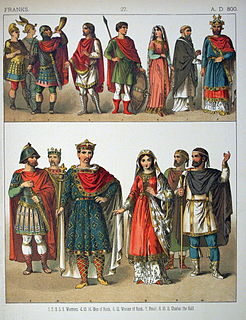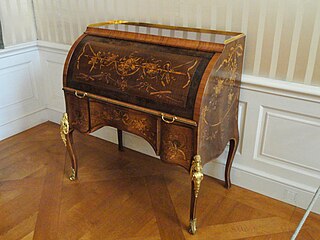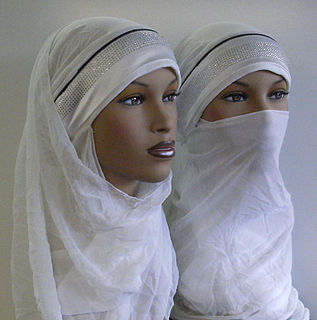
Costume is the distinctive style of dress of an individual or group that reflects class, gender, profession, ethnicity, nationality, activity or epoch.

Pope Clement VII, born Giulio di Giuliano de' Medici, was head of the Catholic Church and ruler of the Papal States from 19 November 1523 to his death on 25 September 1534. “The most unfortunate of the Popes,” Clement VII’s reign was marked by a rapid succession of political, military, and religious struggles—many long in the making—which had far-reaching consequences for Christianity and world politics.

A hairstyle, hairdo, or haircut refers to the styling of hair, usually on the human scalp. Sometimes, this could also mean an editing of facial or body hair. The fashioning of hair can be considered an aspect of personal grooming, fashion, and cosmetics, although practical, cultural, and popular considerations also influence some hairstyles.

Shorts are a garment worn over the pelvic area, circling the waist and splitting to cover the upper part of the legs, sometimes extending down to the knees but not covering the entire length of the leg. They are called "shorts" because they are a shortened version of trousers, which cover the entire leg, but not the foot. Shorts are typically worn in warm weather or in an environment where comfort and air flow are more important than the protection of the legs.

The cylinder desk is a desk that resembles a Bureau Mazarin or a writing table equipped with small stacked shelves in front of the user's main work surface, and a revolving cylinder part that comes down to hide and lock up the working papers when the desk is not in use.

A crinoline is a stiff or structured petticoat designed to hold out a woman's skirt, popular at various times since the mid-19th century. Originally, crinoline described a stiff fabric made of horsehair ("crin") and cotton or linen which was used to make underskirts and as a dress lining.

The abaya "cloak", sometimes also called an aba, is a simple, loose over-garment, essentially a robe-like dress, worn by some women in parts of the Muslim world including North East Africa, Somalia, Morocco, and the Arabian Peninsula. Traditional abayat are black and may be either a large square of fabric draped from the shoulders or head or a long kaftan. The abaya covers the whole body except the head, feet, and hands. It can be worn with the niqāb, a face veil covering all but the eyes. Some women also wear long black gloves, so their hands are covered as well. It is common that the abayat is worn to special occasions, such as Mosque visits and Islamic Holiday celebrations for Eid al-Fitr and Eid al-Adha.

A coif is a close fitting cap worn by both men and women that covers the top, back, and sides of the head.

A gown, from the Saxon word, gunna, is a usually loose outer garment from knee- to full-length worn by men and women in Europe from the Early Middle Ages to the 17th century, and continuing today in certain professions; later, gown was applied to any full-length woman's garment consisting of a bodice and attached skirt. A long, loosely fitted gown called a Banyan was worn by men in the 18th century as an informal coat.

The hennin was a headdress in the shape of a cone, steeple, or truncated cone worn in the late Middle Ages by European women of the nobility. They were most common in Burgundy and France, but also elsewhere, especially at the English courts, and in Northern Europe, Hungary and Poland. They are little seen in Italy. It is unclear what styles the word hennin described at the time, though it is recorded as being used in French in 1428, probably before the conical style appeared. The word does not appear in English until the 19th century. The term is therefore used by some writers on costume for other female head-dresses of the period.

Fashion in the period 1500–1550 in Western Europe is marked by voluminous clothing worn in an abundance of layers. Contrasting fabrics, slashes, embroidery, applied trims, and other forms of surface ornamentation became prominent. The tall, narrow lines of the late Medieval period were replaced with a wide silhouette, conical for women with breadth at the hips and broadly square for men with width at the shoulders. Sleeves were a centre of attention, and were puffed, slashed, cuffed, and turned back to reveal contrasting linings.

A justacorps or justaucorps is a long, knee-length coat worn by men in the latter half of the 17th century and throughout the 18th century. The garment is of French origin, and was introduced in England as a component of a three-piece ensemble, which also included breeches and a long vest or waistcoat. This ensemble served as the prototype of the frock coat, which in turn evolved into the modern-day three-piece suit.

Fashion in 15th-century Europe was characterized by a series of extremes and extravagances, from the voluminous robes called houppelandes with their sweeping floor-length sleeves to the revealing doublets and hose of Renaissance Italy. Hats, hoods, and other headdresses assumed increasing importance, and were draped, jewelled, and feathered.

Metal corsets are a type of historical corset or bodice made entirely out of metal, usually iron or steel. The metal corset was popularly claimed to have been introduced to France by Catherine de' Medici in the 16th century, although this is now considered a myth. The idea that such garments were worn for fashionable purposes is debatable, with fashion historians now regarding such claims sceptically. Many of the original metal bodices that have survived are now believed to have been intended for medical purposes as orthopaedic support garments and back braces. Such garments were described by the French army surgeon Ambroise Paré in the sixteenth century as a remedy for the "crookednesse of the Bodie."

A peascod belly is a type of exaggeratedly padded stomach that was very popular in men's dress in the late 16th and early 17th centuries. The term is thought to have come from "peacock," or from the form of contemporary plate armour. Sometimes it was called a 'goose belly.'

The clothing worn by plague doctors was intended to protect them from airborne diseases. The costume, used in France and Italy in the 17th century, consisted of an ankle length overcoat and a bird-like beak mask, often filled with sweet or strong smelling substances, along with gloves, boots, a wide-brimmed hat, and an outer over-clothing garment.
This is a list of encyclopedias and encyclopedic/biographical dictionaries published on the subject of art and artists in any language. Entries are in the English language unless stated as otherwise.

A ferronnière is a style of headband that encircles the wearer's forehead, usually with a small jewel suspended in the centre. The original form of the headband was worn in late fifteenth-century Italy, and was rechristened a ferronnière at the time of its revival in the second quarter of the nineteenth century for both day and formal and evening wear.

A reticule, also known as a ridicule or indispensable, was a type of small handbag or purse, similar to a modern evening bag, used mainly from 1795 to 1820. According to the American Heritage Dictionary, the name "reticule" came from the French réticule, which in turn came from the Latin reticulum, a diminutive of rete, or "net".
Doreen Yarwood, nee Cawthra (1919-1999) was an English historian of clothing, interiors and architecture.



















